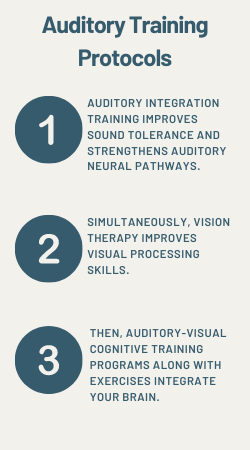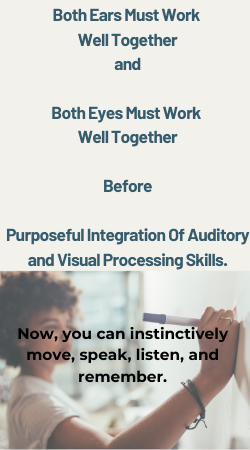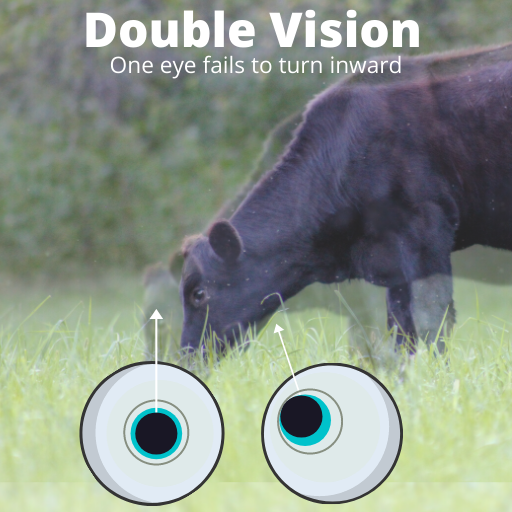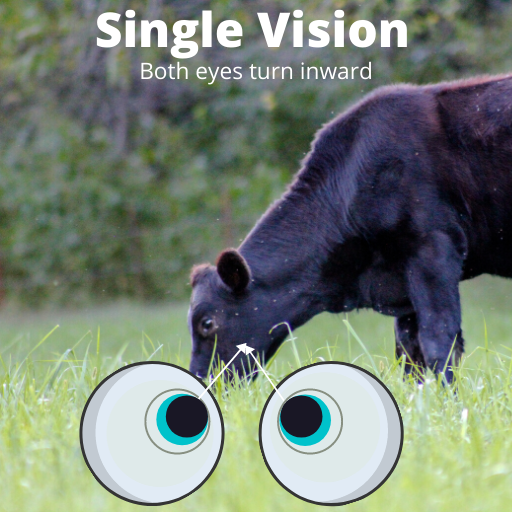Auditory-Visual Training
Cheri developed Auditory-Visual Training Protocols to strengthen clients sound tolerance, auditory and visual processing skills within the same year.
Auditory-Visual Training Protocols
Auditory-Visual Training Protocols create a step-by-step plan for your auditory integration training program. During this time, Cheri ensures your visual system is strong enough to benefit. When visual processing difficulties are diagnosed, Cheri collaborates with your optometrist to optimize clients’ responses to vision therapy and auditory integration training.
Auditory-Visual training protocols are developed using comprehensive hearing and visual processing testing. Before auditory integration training, Cheri uses comprehensive hearing tests to rule out typical and central hearing loss. When hearing aids are recommended, clients respond more strongly to vision therapy and auditory integration training. Most importantly, Cheri works hard to help you maintain progress. Sadly, the most common cause of hearing loss is damage to inner cochlear hairs from loud sounds. However, damage can also occur to outer cochlear hairs. In fact, outer cochlear hairs are damaged more easily than inner cochlear hairs. When damage occurs to outer cochlear hairs, it is more difficult to listen with competing background speech and noise. Undeniably, once cochlear hairs die it is a permanent loss. One day, researchers will learn how to restore the health of cochlear hairs.
Interesting Auditory-Visual Facts
Eye movement, middle-ear bone movement, and speech are all motor movements. When you hear a sound, you instinctively turn your eyes toward the sound. While you look for the source of the sound, you know what you are looking for because you have already labeled the sound.
Have you ever wondered why sounds make you look? Recently, researchers found evidence that what you hear stimulates eye movement milliseconds before your eardrum moves. Your auditory, visual, and motor neural pathways constantly interact.
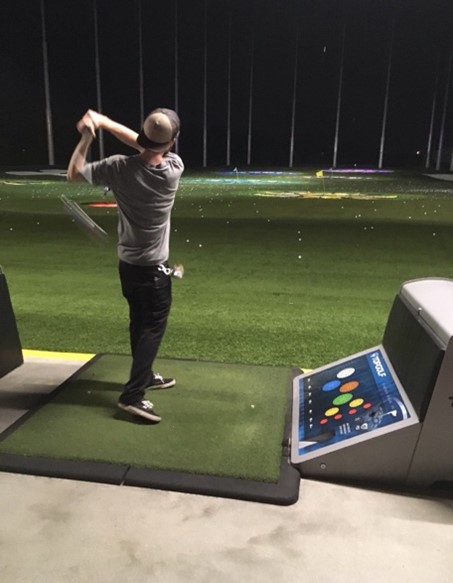
Auditory Integration Training is based on:
- Comprehensive Hearing Test with the help of Cheri
- Comprehensive Visual Evaluation
- Your Moore Auditory-Visual Questionnaire Report
- An Ear, Nose, and Throat evaluation if never seen by an ENT doctor
- Medical history
- Trauma history, injuries
- Emotional health
- Academic challenges
Development of Sound Intolerance on Auditory-Visual Training Protocols
Cheri found that the development of sound intolerance and its underlying cause determine each clients’ auditory-visual training protocols. For example, middle ear nerves and muscles protect the cochlea from harmful sounds. Surprisingly, research shows that when the cochlea fails to protect the brain, the brain protects itself. When overstimulated, the brain instinctively suppresses auditory neural pathways. Interesting, this is one of the reasons you find it difficult to hear after you attend a loud rock concert. Your brain created a temporary hearing loss.
Visual Suppression and Auditory-Visual Training Protocols
The significance of a person’s visual suppression determines their auditory-visual training protocol. A fascinating fact, visual suppression is the brain’s way of suppressing double information. Can you imagine having to consciously process double information? That would be emotionally exhausting. Unfortunately, some children with chronic double vision must figure out which image was real? Equally stressful, double vision disrupts depth perception. Thus, these children quickly tire and avoid distressing activities. For example, stairs and swinging feel unsafe. Thankfully, the brain copes by suppressing information from the second, less clear image, which arrived milliseconds after the first image. Thus, the brain suppresses incoming visual stimulation from the weaker eye. Double vision comes and goes, especially when eye muscles tire.
One of the causes of double vision is lack of eye alignment. The eye that is off-center is suppressed by the brain. When this happens, the eye noticeably moves up, down, inward, outward. When the brain uses incoming visual information from one eye more than the other, unequally stimulation reaches each side of the brain.
Why Complete a Moore Auditory-Visual Questionnaire?
Your Moore Auditory-Visual Questionnaire Report helps Cheri request hearing tests not completed during a typical hearing test. Comprehensive hearing evaluations assess:
- Ear health
- Mobility of eardrum
- Middle ear pressure
- Movement of middle ear bones
- Hearing acuity of inner cochlear hairs and outer cochlear
- Ability to tolerate loud sounds
Cheri completes your Test of Auditory-Visual Skills. Then, writes a report referring you to an audiologist based on findings.
Cost
Cheri understands how overwhelming the cost becomes, especially when more than one family member needs help. Cheri provides:
- Family discounts
- Itemized cost due to individualized needs of each client
- Monthly payment plans.
- Names of organizations that provide financial help for glasses and hearing aids
Learn more about the cost on the Explanation of Cost page.
Advocacy Help for Comprehensive Hearing Evaluations
Cheri connects you with professionals specializing in central auditory processing deficits and difficult to diagnose hearing loss. When requested, Cheri helps you request glasses or hearing aids from a non-profit like the Lion’s Club. Of course, there has to be evidence of financial hardship.
While you wait for your hearing and visual evaluation results, Cheri provides school and workplace accommodation letters. Usually, accommodations decrease stress and anxiety.
If possible, home visits help Cheri observe instinctive responses. Without a doubt, observation activities show you why it is so hard to work at your level of intelligence. Hope is powerful in helping us all become motivated to set goals.
Importance of Medical-Based Auditory-Visual Training
Comprehensive Hearing Evaluation Assessments:
- Ear health
- Eardrum movement
- Middle ear pressure
- Middle ear bone movement
- Hearing acuity of inner cochlear hairs and outer cochlear
- Tolerance to loud sounds
Any type of hearing loss, like trauma from a concussion or a medical condition or poor ear, nose, and throat health weakens your auditory system. Even stimulation from your voice is less strong. Sounds and speech stimulate the whole hearing system: cochlear, auditory neural pathways, and the inner ear’s vestibular system.
Resolving medical issues or identifying the need for hearing aids ensures the brain will continue to receive strong sound energy stimulation upon completion of Auditory Integration Training.
Comprehensive Visual Evaluation Assessments:
- Eye health
- Visual acuity
- Visual processing skills
The inner ear’s vestibular system receives stimulation through movement and from sounds. When your hearing system is under-stimulated, movement is wonderful for your brain. In fact, keeping vestibular pathways strong is essential for walking with balance. Likewise, your ability to coordinate head, neck, and eye movements determines how well your drive. Is your visual system strong enough to handle sound stimulation?
Auditory integration training exercises middle ear muscles improving stimulation along neural pathways to the hearing system. Stimulating the hearing system indirectly stimulates the vestibular system.
Weak Visual Processing Skills Effect Your Auditory System
Sadly, hearing loss creates additional difficulties like weak visual processing skills. Have you ever felt the ground move? If so, I hope it was temporary. Your inner ear’s vestibular system needs stimulation from sound energy and movement. The vestibular system helps you maintain your balance and move your head without feeling off-balance. When visual processing skills are weak, Cheri typically finds sound intolerance with or without hearing difficulties.
Brain Development and Maintenance of Auditory-Visual Processing Skills
Of significant importance, cognitive development and the maintenance of cognitive skills require strong auditory and visual processing skills.
Normally, people think of children when you talk about their brain development. However, your brain needs stimulation from your eyes and ears to maintain strong cognitive processing skills. Thus, stimulation from your hearing and visual system affects all ages, the young and old.
Initially, Cheri was surprised when she found weak visual processing skills in clients diagnosed with hearing loss. Now, Cheri teaches clients how hearing aids benefit their auditory, visual, and motor systems. When there is sound intolerance and hearing loss, clients are able to successfully wear their hearing aids after auditory integration training. Of course, only if they consistently wore their hearing aids.
FDA Statement On AIT
“Auditory Integration Training remediates impairments in auditory discrimination (sound sensitivity and auditory distortion) associated with Autism, Learning Disabilities, and related disorders – ADD, ADHD, CAPD (Central Auditory Processing Deficits), SPD (Sensory Processing Disorder), Dyslexia.“
Are you ready to complete the Moore Auditory-Visual Questionnaire?
Discover what questions to ask and what to observe during visual activities.
Complete the questionnaire to receive your Auditory-Visual Report.

